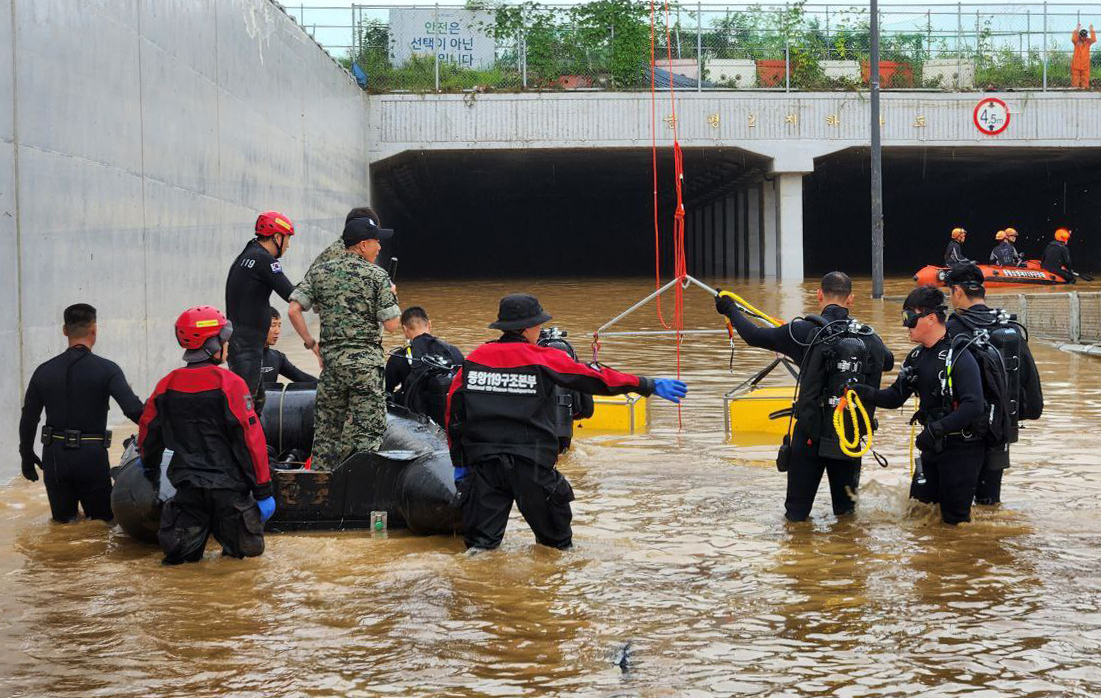Underpass flooding: Could it have been prevented?
No traffic control was in place despite the nearby river being at a dangerous level
By Jung Min-kyung
Published : July 16, 2023 - 15:00

Scores of vehicles were driving through an underpass at around 8:40 a.m. on Saturday morning in Cheongju, North Chungcheong Province, as flooding hit.
The tunnel was only some 600 meters away from the Miho River, a tributary of the Geum River, South Korea's third-largest waterway.
Drivers were apparently unaware that a flood warning for the area had been issued about four hours earlier, due to heavy rain across the country.
No signs or officials were in place to stop traffic entering the underpass tunnel.
At 8:40 a.m., a part of the Miho riverbank collapsed, and water rushed toward the 430-meter-long underpass, immediately flooding it.
Fifteen vehicles, including a public bus, became trapped under the water. The exact number of victims trapped in the tunnel remains unclear, but nine bodies have been recovered as of Sunday afternoon.
An anonymous survivor of the flooding said that it was "impossible to understand why there wasn't anyone controlling traffic near the entrance to the underpass."
Onlookers called the latest incident a "human-made disaster" due to the authorities' slow response.
The Geum River Flood Control Office, the disaster control tower which also oversees the bodies of water around the Geum River, said it issued a flood warning at 4:10 a.m. on Saturday. The warning is the higher of the two-step flood warning system, indicating the seriousness of the situation.
Around 6:34 p.m., the control office called the Cheongju City government via phone to alert the need to issue a possible evacuation order, as well as for traffic control measures.
However, the city government reportedly denied having received no such call.
In a briefing Saturday, a North Chungcheong Provincial government official told reporters that they "had no time" to control the underpass traffic, because the flooding happened so quickly.
"Even after flood warnings are issued, actual flooding needs to be spotted in the middle of the underpass for traffic control to be initiated," the official said.
"There was no time to muster response this time, because the riverbed abruptly collapsed and flooded the tunnel."
As for the collapse of the riverbank, some question whether adequate measures were taken to prevent it from happening. A resident told local media that he witnessed workers hastily reinforcing the riverbank just an hour before the deadly incident.
A local villager living near Miho River told Yonhap News on Sunday that only a single excavator was digging and collecting sand around the site to build a temporary riverbank at around 7 a.m. on Saturday. The villager noted the absence of sandbags which are normally used to build tougher reinforcements around rivers against floods.
"The water had already risen to some 30 centimeters below the temporary riverbank," the villager said.
"(The riverbank) was ready to collapse because it wasn't built out of big sandbags – it was built with mud and sand collected around the river."
Kong Ha-sung, professor of fire protection and safety management at Woosuk University, said that the government announced a plan three years ago to install automatic bars that would block vehicles from entering underpasses in flooding incidents.
"Some underpasses managed to adopt the system, but not the one in Cheongju. The government failed to have all of them installed in time," he added.
In 2021, the government-run Anti-Corruption & Civil Rights Commission requested the Ministry of the Interior and Safety and Ministry of Land, Transportation and Infrastructure to install the automatic system at all underpasses. Underpasses evaluated as "high-risk" for flooding given their steepness and geographic vulnerability should be prioritized in the adoption of the system, the commission explained.
The commission also highlighted the importance of drainage systems in all underpasses, saying that they must all be regularly checked.
All four drainage systems at the underpass in Cheongju failed to work during the flooding, reports said Sunday.
The latest underpass flooding follows a similar incident in Busan in July 2020. Three people died in an underpass flood in Dong-gu after fire authorities missed two calls reporting the accident. The fire authorities explained that they had received "too many" calls that day.
The Busan Metropolitan Government and Dong-gu officials also failed to control the traffic to the underpass despite a heavy rain warning issued an hour prior to the incident.



















